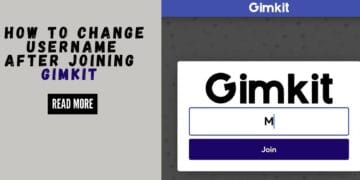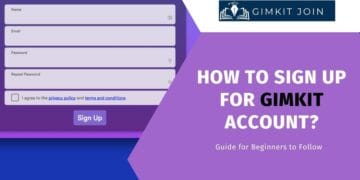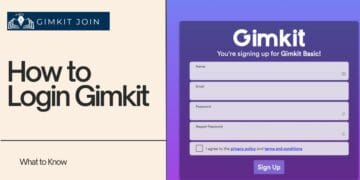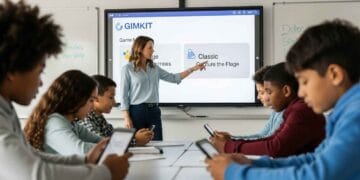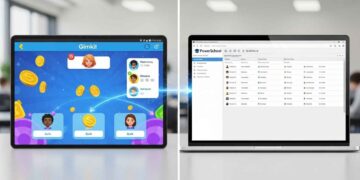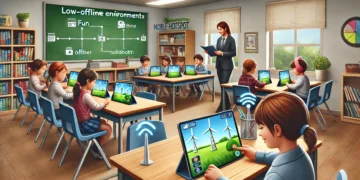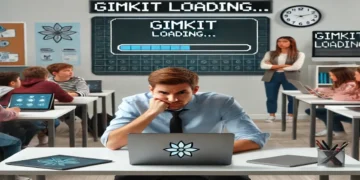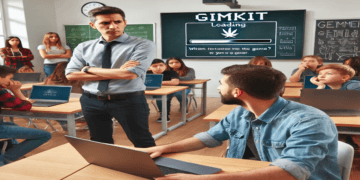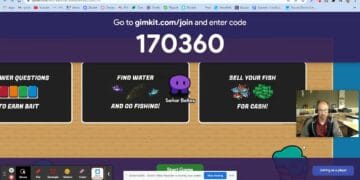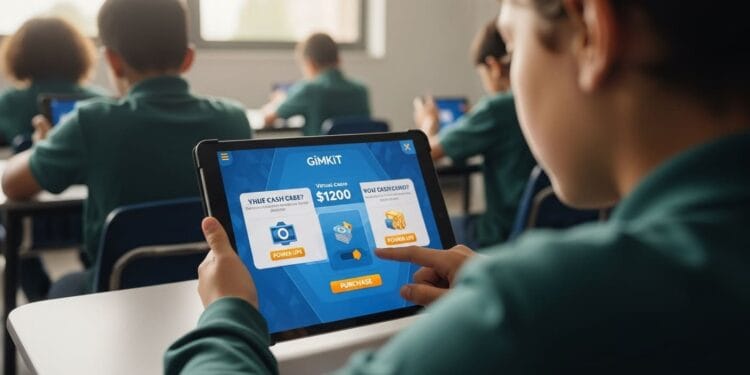In the digital age, the quiet classroom quiz has been transformed into a thrilling, high-energy game show.
Among the tools that have made this possible, Gimkit has become the platform teachers like me turn to when we need genuine student buy-in. It doesn’t just ask questions; it leverages gamification to turn every lesson review into an exciting, strategic experience. Academic meta-analyses have repeatedly confirmed the positive impact of this approach, showing that the integration of game elements can significantly enhance student motivation and learning outcomes.
As an educator and a Gimkit enthusiast, I know you have questions that go deeper than the basic features. This guide is your complete breakdown, explaining exactly what Gimkit is, how its 6 core features work, and why its unique strategic edge helps students learn better than ever before.
If you’re new to the platform, here’s a guide on how to sign up for a Gimkit account to get started.
How Gimkit Works: The 4-Step Engagement Loop
Gimkit’s process is designed to be user-centric and requires minimal setup, allowing you to go from lesson plan to live game in minutes.
- Kit Creation (Content): You create a “Kit” (a set of questions and answers) on any topic. Gimkit is renowned for its Quizlet Integration, allowing you to import existing question sets in seconds, a massive time-saver for busy teachers.
- Game Setup (Strategy): Before starting, you choose a Game Mode (e.g., Classic, Trust No One, The Floor is Lava). You customize settings like time limits, money multipliers, and the target goal. This flexibility ensures the game always meets your specific learning objective. For a detailed view of every option, check out our guide to custom game challenges in Gimkit.
- Playing & Earning (Engagement): Students join with a unique code on any device (laptop, tablet, phone). As they answer questions correctly, they earn virtual “money” (known as Gimkit Cash), which they immediately use to buy power-ups or upgrades. This is the core strategic loop that differentiates Gimkit.
- Analytics & Review (Assessment): The game’s real-time dashboard provides powerful data on class performance and individual accuracy, making it a valuable tool for quick, formative assessment checks.
Gimkit’s 6 Core Features Explained (The Strategic Advantage)
These core capabilities are what sets Gimkit apart from other educational quiz tools and elevates it into a strategic learning platform.
1. Live Multiplayer & The Strategic Economy
 This is Gimkit’s heart. Unlike simple quiz platforms that only reward speed, Gimkit runs on a live, multiplayer economy.
This is Gimkit’s heart. Unlike simple quiz platforms that only reward speed, Gimkit runs on a live, multiplayer economy.
- In-Game Currency & Power-Ups: Students earn money for correct answers and spend it on upgrades (to earn faster) or power-ups (to sabotage rivals). This introduces a layer of critical thinking and financial strategy to the learning process. Students aren’t just memorizing; they are making investment decisions. For advanced earning tips, see our guide on the [suspicious link removed].
- The Research Edge: This gamification model doesn’t just feel fun—it works. Research confirming the impact of Gimkit on student perception found that 95.8% of students rated their experience as “good or very good,” highlighting that enjoyment directly translates to enthusiastic participation, which is key to learning. This specific finding is supported by a study on its utilization for formative assessment in chemistry education.
2. Diverse Game Modes & Student Choice
 Gimkit offers over ten unique game modes, ensuring you can match the game to your learning goal and keep students from getting bored. To keep things fresh, you should be exploring Gimkit’s game modes regularly.
Gimkit offers over ten unique game modes, ensuring you can match the game to your learning goal and keep students from getting bored. To keep things fresh, you should be exploring Gimkit’s game modes regularly.
| Game Mode | Pedagogical Goal | Why It’s Unique |
| Classic | Core Review & Fluency | Simple, fast-paced challenge with the money element. |
| Team Mode | Collaboration & Community | Forces students to communicate and pool resources toward a class-wide goal. If you’re torn between teaching styles, read about competitive vs cooperative learning in Gimkit. |
| Trust No One | Critical Thinking & Intrigue | Students must identify an “Impostor” (a concept unique to Gimkit), promoting suspicion and deep focus. |
| The Floor is Lava | Active Review & Movement | A 2D game environment that gets students moving (if using movement-based controls) and thinking quickly. |
3. Adaptive Learning Algorithms
 Gimkit uses a subtle adaptive engine that changes the frequency and difficulty of questions based on how a student performs. This ensures that every student receives tailored instruction and minimizes time spent on concepts they already know, supporting Gimkit in special ed settings and for diverse learners.
Gimkit uses a subtle adaptive engine that changes the frequency and difficulty of questions based on how a student performs. This ensures that every student receives tailored instruction and minimizes time spent on concepts they already know, supporting Gimkit in special ed settings and for diverse learners.
4. Real-Time Data & Analytics
 The teacher dashboard provides powerful, instantaneous feedback.
The teacher dashboard provides powerful, instantaneous feedback.
- Formative Assessment: You get instant data on group and individual performance, helping you identify areas of weakness before the test. This makes Gimkit ideal for formative assessment.
- Data-Driven Instruction: Gimkit’s immediate feedback model aligns with Constructivist learning theory, which posits that learners actively build knowledge through experiences and reflection. By providing timely, actionable data, Gimkit acts as a powerful guide, reinforcing the principles of active learning and self-correction.
- For a detailed guide on interpreting this data, read more on how to track student progress in Gimkit and the Gimkit dashboard guide.
5. Quizlet Integration & Content Sharing
 Gimkit respects the teacher’s time. Its ability to seamlessly import existing question sets from Quizlet saves countless hours of content creation. Furthermore, the platform encourages a community of educators by allowing you to easily share custom-made Kits with colleagues, fostering an environment of resource exchange and encouraging you to join relevant teacher communities for sharing Gimkit tips.
Gimkit respects the teacher’s time. Its ability to seamlessly import existing question sets from Quizlet saves countless hours of content creation. Furthermore, the platform encourages a community of educators by allowing you to easily share custom-made Kits with colleagues, fostering an environment of resource exchange and encouraging you to join relevant teacher communities for sharing Gimkit tips.
6. Fostering Collaboration (KitCollab)
 Gimkit offers features that turn students from passive players into active contributors. The KitCollab feature allows students to contribute their own questions and answer choices to a Kit before the game begins. This student ownership is a powerful tool for promoting higher-order thinking and increasing investment in the learning material.
Gimkit offers features that turn students from passive players into active contributors. The KitCollab feature allows students to contribute their own questions and answer choices to a Kit before the game begins. This student ownership is a powerful tool for promoting higher-order thinking and increasing investment in the learning material.
How Teachers Actually Use These Features in Real Classrooms (Middle School Case Examples)
The real magic of Gimkit is seeing how these powerful features translate into diverse middle school subjects. Here are two examples of teachers leveraging Gimkit for specific learning goals:
Case Study 1: Strategic Review in a 7th Grade History Class
- Teacher: Mr. Adam, 7th Grade Social Studies
- Goal: Formatively assess understanding of the US Constitution’s Amendments while promoting critical thinking and debate.
- Feature Used: The “Trust No One” Game Mode.
- Outcome: Mr. Adam structured the questions around “Which Amendment protects this right?” The competitive nature of “Trust No One” (where one or two players are impostors trying to steal cash) forced students to be highly accurate. The tension and required communication during discussions naturally led to students citing the specific amendment and its purpose to prove their innocence, resulting in deeper, involuntary content review and application of Gimkit’s interactive features.
Case Study 2: Differentiated Practice in 8th Grade Math
- Teacher: Ms. Belly, 8th Grade Algebra
- Goal: Drill practice on solving multi-step equations and incentivize slower, more accurate work over speed.
- Feature Used: The Strategic Economy (Classic Mode with a Focus on Multipliers).
- Outcome: Ms. Belly used the real-time data to identify students who struggled with accuracy but were fast. She encouraged these students to use their earned Gimkit Cash to immediately buy the “Multiplier” upgrade instead of the “Speed” upgrade. This strategic spending decision forced them to prioritize answering questions correctly (to maximize the multiplier) over rushing. The result was improved overall accuracy and a lesson in long-term financial strategy, alongside the math review.
Gimkit vs. The Competition: Why Strategy Wins
Teachers often ask how Gimkit compares to other popular gamified tools like Kahoot or Blooket. The answer lies in its strategic learning mechanics. For a full debate on this topic, read which is better: Gimkit or Blooket?.
| Feature | Gimkit | Kahoot! | Blooket |
| Core Mechanic | Strategic Investment & Repetition | Speed & Accuracy (Game Show Format) | Variety of Game Modes (Luck & Speed) |
| In-Game Economy | YES. Money is earned and spent on upgrades/sabotage. | NO. Points are earned for score only. | YES. Coins are earned to buy avatars (Blooks), not game upgrades. |
| Learning Style | Adaptive Repetition and strategic thinking. | Immediate, high-energy review. | Fun, light-hearted review. |
| Teacher Analytics | High Detail (Real-time tracking, earnings, accuracy). | Moderate Detail (Final scores and leaderboard). | Moderate Detail (More limited in free version). |
| Best For… | Deep content mastery, critical thinking, and long-term retention. | Quick, whole-class energy boosts and simple review. | Simple, fun reviews and catering to varied student preferences. |
The Strategic Takeaway
 Gimkit’s in-game money system adds an extra cognitive layer that encourages students to keep answering questions—not just to win, but to earn and spend. This sustained engagement directly leads to repeated exposure to the content, which is the gold standard for memory retention and improved learning outcomes.
Gimkit’s in-game money system adds an extra cognitive layer that encourages students to keep answering questions—not just to win, but to earn and spend. This sustained engagement directly leads to repeated exposure to the content, which is the gold standard for memory retention and improved learning outcomes.
Conclusion
With its dynamic blend of competition, collaboration, and adaptive learning, Gimkit is a powerful tool that moves beyond simple quizzes. The main features of Gimkit—from its strategic in-game economy to its powerful real-time analytics—provide teachers with a versatile and effective platform to increase classroom engagement and drive measurable learning results.
By encouraging autonomous thought, strategic decision-making, and healthy competition, Gimkit provides a memorable and successful learning path for students. If you want to dive deeper into maximizing your use, start by mastering the game modes or exploring Gimkit’s interactive features.
Frequently Asked Questions (FAQs)
What is the main feature that distinguishes Gimkit from Kahoot! or Blooket?
Gimkit's key differentiator is its strategic, in-game economy where students earn virtual currency (Gimkit Cash) for correct answers and then spend it on power-ups or upgrades. This introduces a strategic, investment-focused layer that goes beyond simple speed and score.
What type of assessment is Gimkit best suited for?
Gimkit is highly effective for formative assessment because it provides teachers with real-time, detailed data on individual and class performance, allowing them to instantly identify and address knowledge gaps before a summative exam.
How does Gimkit support different learning theories?
Gimkit’s immediate feedback model and student-driven pace align strongly with the Constructivist Learning Theory. This theory emphasizes that learners actively construct knowledge by receiving feedback and reflecting on their experiences to make necessary corrections.
What is Gimkit’s KitCollab feature?
KitCollab is a collaboration feature that allows students to contribute their own questions and answers to a quiz Kit before the game starts. This increases student ownership of the content and promotes higher-order thinking and preparation.






